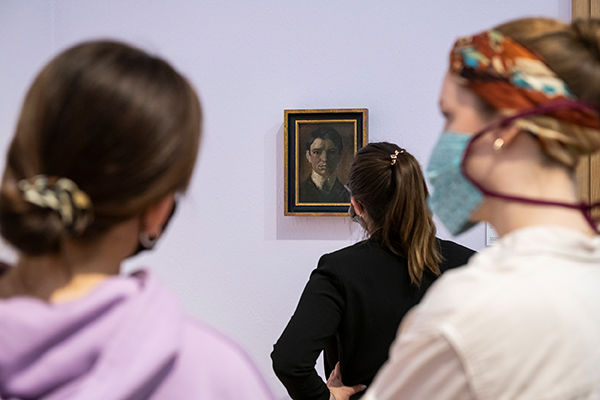The banners in the Portikus at the entrance to Museum Wiesbaden announce the new special exhibition. Photo: Museum Wiesbaden
Our August Macke exhibition comprises multiple levels, the first of which is our major theme: ‘Paradise! Paradise?’ with its poignant relevance to our own time. Often, we don’t realize how good life is until what was once taken for granted has passed. Only then do we appreciate our previous good fortune, and the ordinary becomes something to be savoured. Currently, this applies not just to you but to us as well: the gates to the ‘Temple of Art’ have slammed shut, the galleries are under lock and key, and we have all been expelled from Macke’s ‘Paradise’.



Despite the desire in every fibre of his work to ‘fill the world with delight’ simply by flicking a switch and flooding the drabness of everyday life with light, August Macke (1887–1914) was well aware of the fragility of any paradise. Take his tightrope walkers, for example, who, with tremendous poise, inch their way through life in electrifying steps wearing radiant smiles, despite the fact that at any moment they might lose their balance and fall; or the enchanting evening mood that may at the very next moment be extinguished by the blackness of night falling. Both images allude to the transience of things.
... are - in Macke’s case, of course - paramount, which is why we are very much looking forward to opening our galleries to our visitors again.



A second, less obvious level of the exhibition is its connection with our museum’s own history. While strolling through the exhibition many visitors may or may not be aware that in 1920 – exactly one hundred years ago – these very same halls hosted a major memorial exhibition for August Macke, encompassing over 190 works. We have used this anniversary as an opportunity to draw attention to the fact that Wiesbaden was not always just an administrative centre, a venue for the Kaiserfestspiele, or a fashionable spa town where people came to take the waters.
In fact, for at least a decade after the First World War, it became a hub of the avant-garde. A major Frank Marc retrospective was shown here in 1917 and subsequently the progressive collector Heinrich Kirchhoff promoted not only Jawlensky, Klee and Nolde, but also the cosmic works of Kandinsky, the torn works of Schwitters and the geometry of Moholy-Nagy. All this cast Wiesbaden in a supporting role as a well-known ‘second modernist stronghold’ that took its cues from Berlin.
Translation: Lance Anderson